Back to warmer waters

honking



honking

By Murray Green Fitness instructor Rox anne Claude will be offer ing Pink Classes in October to support the Alberta Can cer Foundation.

Held at Martinson Health, these classes are donation fitness classes, with 100 per cent of the proceeds going to the Al berta Cancer Foundation in honour of Breast Cancer
Awareness month. There will also be Alberta Health Services educators to bring awareness to early testing and self exams.

The classes run Octo ber 7, 14 and 21 beginning at 6 p.m. “I encourage ev eryone to wear pink at the classes to show their sup port. I want high energy, good music and lots of fun,” explained Roxanne.

“My time and every thing is donated, so we are asking for a minimum of a $10 donation. My goal is to raise $2,000, but any amount is good. I’m sending the funds to the Cross Can cer Institute because that is where my mom went.”
To register for the class es, go to martinsonhealth. com or text 587-338-9239 for more information.
I frequently think about farmers this time of year. My dad is likely to get a few extra phone calls and text mes sages from me checking in with how the crops are, how rain or breakdowns may be interrupting progress, or how he is doing generally. I think about other farmers as well, not just because of the extralong work days of harvest, the unpredictability of the market and weather, or the isolation and the debt loads, but also because of my awareness of the impact that these stressors have on farmers’ mental health.
Research conducted by the University of Guelph in 2015 showed that 35 per cent of farmers were classified with depression, 45 per cent reported high stress, and 58 per cent fell into the category of anxiety. In a follow up study in 2021, it was shown that moderate or high perceived stress was experienced by 76 per cent of farmers and one in four Canadian Farmers considered taking their life in the previous year. These are alarming statistics. Importantly, these findings don’t just apply to men. Mental health symp toms were found to be higher in women than men on every measure except alcohol use. This is thought to be a result of the stress of on-farm and off-farm responsibilities that many women juggle, in addition to parenting and spousal support.

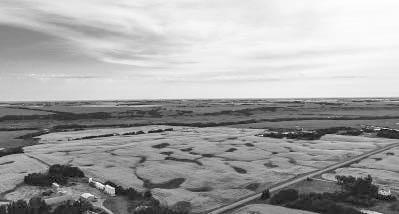



As a psychologist in Camrose, I often hear stories from farmers about how difficult it is to reach out for support due to stigma, cost, time demands, or not knowing how to find a therapist, especially a therapist who understands farming. Indeed, of the strongest barriers to seeking help consis tently mentioned by farmers is the desire to talk to some one who understands farming. Meeting with a therapist who in the first session suggests they take “a few days off” can send a farmer out the door without ever coming back. Farm ers benefit from a therapist who understands the demands of the job, the unique stressors associated with farming (in cluding how impossible “a few days off” is), as well as the ties, often intergenerational, that farmers feel to their land and livestock.
The good news is that awareness of the mental health concerns specific to farmers and the need for farm specific support is increasing. Several provinces have developed in dependent mental health programs specific to each prov ince, most of which include free or subsidized access to mental health supports for farmers.
In Alberta, easily accessible, coordinated mental health resources for farmers are lacking. While there are therapists with various training dotted across the province, including myself and other therapists at my practice who have agricul ture backgrounds, there continue to be barriers preventing farmers from reaching out for support.

Recently, the Agricultural Research and Extension Coun cil of Alberta (ARECA) has been working to address the gap in mental health care for farmers in Alberta. ARECA and the U of A’s Augustana Campus recently paired up to complete a needs assessment examining the mental health needs of farmers in Alberta. Some of the key recommendations from this assessment include the need for a central location for farmers and their families to connect with resources and therapists, as well as the need to increase heath care pro vider knowledge of concerns unique to farming and treat ment approaches most appropriate for farmers.
From this work, the Alberta Farm Mental Health Net work will be rolled out this fall. The Network will provide ac cess to resources as well as a listing of local therapists who have a background in agriculture or training in farm-culture knowledge, all easily accessible to farmers.
Farming is an occupation like no other. The rewards can be tremendous including the gratifying feeling of waking up to a farm that exists as a result of the hard work of your own two hands, watching your children roam freely through fields or learning to care for animals, or the feeling of together ness as the whole family works to complete a harvest. The challenges, including uncertainty, debt, and isolation, are also tremendous and can come at a cost. If you are a farmer looking for support, or if you know of a farmer who is strug gling, it is my hope that you do not hesitate to seek support. There is a joke that the farmer pain threshold is much higher than it is for the average citizen. You do not have to wait until you are at the end of your rope to have a chat.
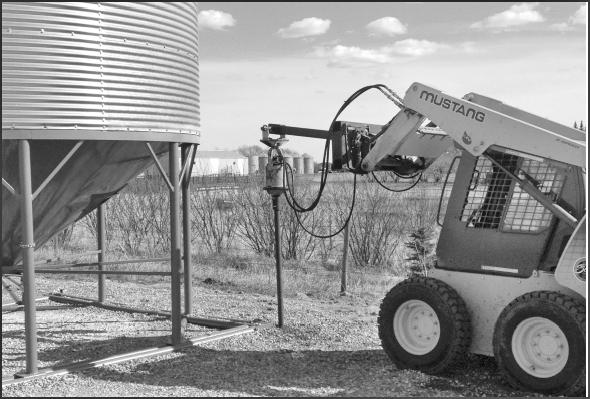

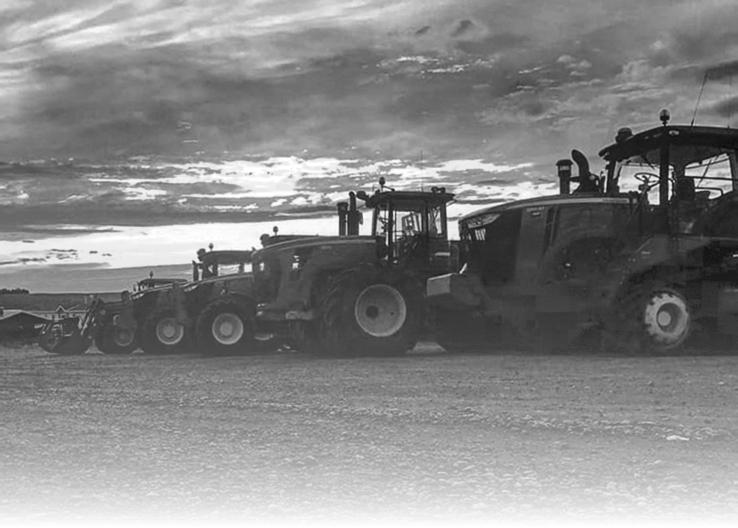


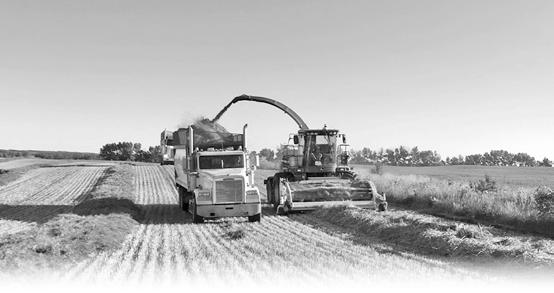
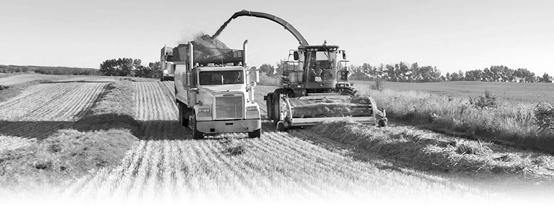









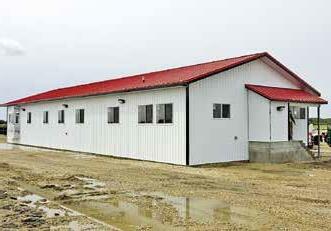



























Effective August 1, changes to the Federal Mi gratory Bird Regulations, 2022 will have an impact on migratory bird hunters, outfitters and guides.
Camrose and District Fish and Wildlife, District Officer Lorne Rinkel ex plains.
“The Migratory Bird Convention Act and Reg ulations (a federal Act regulated by the Govern ment of Canada) were im plemented in Canada in 1918,” said Rinkel. “The Act was amended this year by parliament and came into effect on August 1.”
area; (b) in a location other than the hunting area, had its edible portions removed from its carcass and then been frozen, made into sau sage, cooked, dried, canned or smoked; or
(c) been mounted for taxidermy. (préparé).
“This is big,” said Rin kel. “Especially for outfit ters because of the sheer volume of birds harvested by the hunters they guide. Clients coming into Al berta might not necessar ily want to take hundreds of geese home. So the out fitter would be left with them. Now they (outfitters/
(could be from other coun tries as well) hunters using guide/outfitters were not allowed to bring their birds back across the border be cause of the highly patho genic avian influenza (bird flu).”
Rinkel said that these changes were made to put these excess birds to use. “One of the sad things I have seen in the past is piles of geese dumped in the ditches. We frequently get calls about abandoned geese and ducks.”
Another major im pact of this change to the Act is that any harvested game birds that fall under
the harvested birds when transporting, to assist Fish and Wildlife or other offi cers in identifying the spe cies of the bird.
“To some hunters this change is important, be cause a fully feathered head takes up a lot less room in a cooler than a fully feath ered goose wing,” noted Rinkel.
Game birds found shot and picked up now count in the hunters’ possession limit, even if they were shot by someone else.
“What would some times happen in the past with some hunters found over their limit, is they would state they picked up found birds.”
Other changes that Rinkel wanted to draw at tention to include changes to nest protection under the Act and Regulations.
“Migratory bird nests are protected. You can’t remove them, damage or destroy them, anything. The main nest of concern is those of eagles.
“This legislation has made an allowance if there is confirmation that the nest is no longer in use then they can get rid of it. The person will still have to go through the Minister, but
The Federal govern ment can also issue Damage or Danger Control permits for migratory birds for the purposes of scaring or kill ing birds. “This is typically for around harvest of crops when massive amounts of geese and or ducks come in. Farmers can get a Damage or Danger permit to shoot migratory birds, specifi cally geese, all year no lim its, essentially to eradicate geese ruining crops.”
Now, in accordance to the changes to the Act/Reg ulations, the birds can be taken under certain Dam age and Danger permits and gifted out. “Once again this is really focusing on not wasting the birds.”
On a final note Rin kel reminded hunters that hunting of migratory game birds is federally regulated. “Game bird hunters require three licences, a valid Fed eral Migratory Game Bird Hunting (MGBH) permit on which the Canadian Wildlife Habitat Conser vation (CWHC stamp) ap pears; Alberta Provincial Bird Hunting licenses and an Alberta Hunting license.
“The enforcement of this federal regulation is spearheaded by the Federal Game Wardens,” noted Rin
Flocks of geese and ducks can be heard overhead and seen in fields and on waterbodies around the county as they begin the migration to warmer waters.


Rinkel focused on chang es more particular to the Camrose area, specifically hunting, including the in troduction of the free Mi gratory Game Bird Hunt ing (MGBH) Permit and Canadian Wildlife Habitat Conservation Stamp for youth / minors (under 18 years of age).
“Youth must hunt with a mentor (adult), and may benefit from the entire open and special conservation seasons, with their own bag and possession limit,” explained Rinkel adding that in the hunting world, migratory birds include all ducks, geese (Canada, snow, white-fronted goose [speckle bellied] and Ross’s) and sandhill cranes.
Another significant change in the legislation states harvested (hunted) birds can now be donated for charitable purposes.
A new Charity Permit, allows the permit holder to accept harvested preserved birds, and to serve them as a meal (charitable dinner or soup kitchen) or to give them to customers of a food bank.
Preserved, as defined in Section 1 (1) means, with respect to a migratory game bird, one that has:
(a) been eviscerated and plucked in any location and then been frozen, made into sausage, cooked, dried, canned or smoked in a loca tion other than the hunting
guides) can give them out to food banks and charities (once preserved as per the definition).”
Along with that change, as of September 12 USDA (United States Department of Agriculture) APHIS (Animal And Plant Health Inspection Services) will be allowing the import of hunter harvested wild bird meat/carcasses in accor dance to the following con ditions:
• viscera (guts), head, neck, feet, skin, and one wing have been removed;
• feathers have been re moved, with the excep tion of one wing–as re quired by US Fish and Wildlife Services (FWS) for species identification;
• carcasses must be rinsed in fresh, clean, potable water prior to packaging and must not have vis ible evidence of contami nation with dirt, blood or feces;
• carcases must be import ed in leak-proof plastic packaging and stored in a leak proof cooler or con tainer during transport and import;
• and carcasses must be chilled or frozen during transport and import.
“Up until September 12 any migratory birds that guided hunters shot were strictly prohibited from leaving Canada,” said Rinkel. “A lot of American
the definition of preserved would no longer count to wards the hunter’s posses sion limit.
“Once a hunter has their possession that is it,” said Rinkel adding that they often come upon over possession limits when con ducting search warrants. “Now, once the birds are preserved, as per the defi nition, a person can go back to filling their original pos session limit.”
Other changes to the Act and Regulations in clude the following.
Prohibiting the use of drones for hunting migra tory birds, similar to big game hunting.
Allowing for the attach ment of a fully feathered head (or wing) on harvested unpreserved birds. “Prior to changes bird hunters used to have to have a fully feathered wing attached on
there is loosened up legis lation around abandoned nests.”
Rinkel added that it is not a huge concern around Camrose, but he has re ceived the odd call inquir ing as to whether or not a person can get rid of a nest (hawks or otherwise).
According to the chang es in the Act/Regulations, the nest of all migratory bird species are protected when they contain a live bird or viable egg (generally during the nesting period).
The Act also states that the nests of 18 species (listed in Schedule 1 of the regulations), whose nests are reused by migratory birds, continue to have year round nest protection, un less they have been shown to be abandoned, which is explained further in the Act.
kel. “As a game warden in Alberta, I enforce provin cial law but also have ap pointment to enforce Fed eral law.”
Camrose Fish and Wildlife district was re cently expanded to include the area north all the way to Highway 14, making the north boundary now from Edmonton to Viking.
As well the Camrose Fish and Wildlife office is back to operating with only one officer. Anyone wishing to contact the Camrose of fice can do so by telephon ing the Report a Poacher line at 1-800-642-3800
For complete details on the Migratory Birds Regulations, 2022 visit / www.canada.ca/en/envi ronment-climate-change/ services/migratory-gamebird-hunting/regulationsprovincial-territorial-sum maries.html.
Adaeze completed her medical education and postgraduate training in Nigeria. She is enthusiastic about o ce practice with care for all age groups. Her practice interests include acute care and emergenc y, preventive medicine, chronic disease management and women centred care with special interest in extende d Obstetrics. She is married with four kids and has just moved with her family to the beautiful city of

short stay here,

kids love Camrose


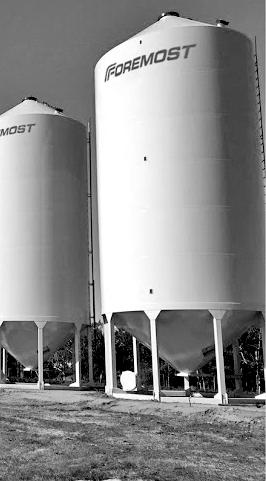
patient-


























Or the past two weeks I have conducted my sixth round of door knocking throughout the constitu ency. We have completed all of the towns that we advertised, but given time restraints have not made it to every door. First, I would like to thank everyone for their engagement and providing feedback to me as their MLA.
I was happy to talk about the gas tax relief that our government has provided by removing the provincial gas tax including on marked farm fuel, to give Alber tans the relief that they need right now at the pump. I was also happy to talk about the electricity rebate. Over 1.9 million homes, farms, and businesses will receive a total of $300 in rebates over six months to cover high electricity costs. We talked about the fact that our government has balanced the budget and this is only the second time this has been achieved in over a decade. This point was particularly important to many of the constituents I had the pleasure to speak with. We talked about how Alberta has an unemploy ment rate of 4.8 per cent, which is the lowest rate since 2015. Alberta has gained 15,000 new jobs in the month of July alone.
Over the next couple of weeks I plan to continue with my door knocking effort and I’m grateful for the assistance of the volunteers who helped me with the effort thus far. We have over 40,000 constituents in our community and I’ve given my best effort to speak to as many face-to-face as I can. As always, your con cerns and comments are important to me. Anyone who requires my assistance with casework is strongly encouraged to contact my office at 780-672-0000. My office is located in the Central Agencies building in Camrose. We return to session on October 31 and I’m scheduled for a Motion and a Bill. I look forward to the next session and the opportunity to serve as your voice in the Alberta Legislature as your MLA and Par liamentary Secretary to the associate minister for the Status of Women.
If you have any questions or concerns, contact my office. We are always here for you!
You can contact Jackie Lovely, Camrose MLA, at Constituency Office, 104, 4870-51 Street, Camrose, AB T4V 1S1. Tel: 780-672-0000, camrose@assembly. ab.ca or at Legislature Office, 6th Floor, 9820-107 Street, Edmonton, AB T5K 1E7.

Darryl Schultz from near Bittern Lake was harvesting wheat when he experienced an electrical storm on September 15. He was tracking the storm on the weather radar and hoping it was going to miss his farm. Instead he was treated to the light show, but also felt the electric tension in the air. Most grain producers harvest late at night to take advantage of dry conditions prior to a storm. His farm is located north of the junction of Highways 13 and 21.
Lori Larsen, Camrose Booster Chocolate, the watcher of the herd, takes the highest point on a piece of land to watch over her herd of sheep. Llamas are instinctively alert, very aware of their surroundings. They will often draw attention to an intruder, including predators, by making a startling alarm call that sounds like a rusty hinge. They have also been known to walk or run toward an intruder and chase, kick or spit at it.
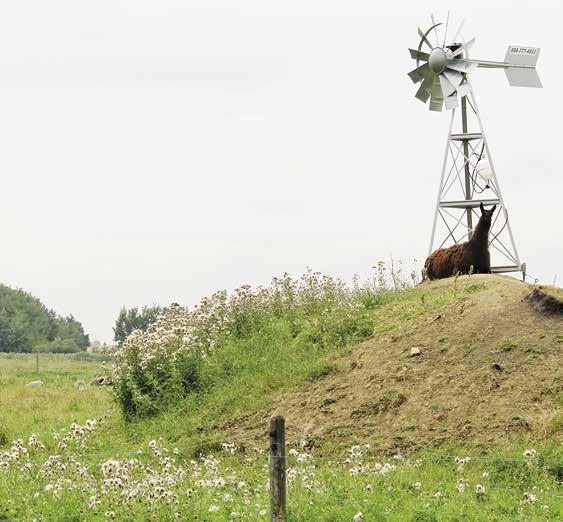
 By Murray Green
By Murray Green
Camrose County is al ways looking for ways to improve the road mainte nance system.
“I move that Camrose County council authorize the purchase of a new quick attach gravel reclaimer with rear arm, quick attach seven and a half foot mower, front mount mulcher with spiral drum from Capital I Industries for the quoted price of $158,167 plus GST, with funding to come from the Public Works reserve,” said councillor Don Simp son.
“The County shoulder pulling program is cur rently completed by a hired contractor. Aside from this contractor, Camrose Coun ty does not have any sig nificant means of complet ing road repairs with the departure of the shoulder pulling equipment back in
2020. While the attach ments being proposed are not going to replace a full fledged shoulder pull proj ect, it will provide the abil ity to complete a “mini” shoulder pull with a single unit, which should ad equately address a signifi cant number of minor road issues,” said Public Works manager Zach Mazure.
The roadside mow ing program is currently a service that is completed by the Agricultural Ser vices department utiliz ing two tractors equipped with rear-mounted mowers. Mower operators are hired seasonally and the work oc curs over several weeks in the summer months.
Approximately 550 to 600 hours are put on each unit on an annual basis and the estimated cost of the program is $65,000$70,000 annually. Being
that this work largely hap pens within the County road right-of-way, and serves a functional purpose for the maintenance of the roadways, the Public Works department is interested in taking over this task and utilizing a heavy-duty grader-mounted mower,” suggest Zach.
A demonstration of the unit(s) in question was completed on June 22 with Capital I Industries. They provided information on the use of the units, dem onstrated use of the equip ment and answered ques tions on maintenance and operation.
“Staff from manage ment, shop and operations were all in attendance for this demonstration and the general consensus was that the units should perform as intended/desired,” added Zach in his report to council.
“Camrose County as sets are managed in a sus tainable manner, that max imizes useful life, while recognizing the financial and environmental com mitments to our residents,” he pointed out.
County assets will be maintained to optimize their maximum useful life, with the intention to lower the cost of ownership and investment in infrastruc ture will be done strategi cally to improve condition and lower risk.
“While this is an un budgeted expenditure of $158,167 for 2022 to be pulled from reserves, the same amount should be contributed back to re serves in 2023 and can be taken from the allocation to what would otherwise be dedicated to a shoulder pull contractor,” said Zach.
“There would be ongo
ing maintenance and op erational expenses associ ated with this unit for the estimated 1,200 hours/year. It is believed that a sea sonal operator would be the best option for this unit and while some of the mainte nance costs associated are unknown (teeth, wear com ponents, breakdowns), an estimated cost of $111,336 is anticipated. The expecta tion would be that a portion of this could be covered by decreasing the demand on the agricultural services mowing program and de creasing the amount of ex penditure allocated to the contracted shoulder pull,” Zach added.
“Essentially, the overall intent would be to balance annual operational expen ditures such that the Coun ty sees an increased ability to perform tasks/functions without an increased cost.”













 By Murray Green
By Murray Green
Camrose County set this winter’s gravel hauling rates at the regular meeting on September 27.

“I move that Camrose County council approve the 2022-23 winter gravel haul rates of $1.12 per tonne (loading factor) and $0.3 per tonne multiplied by mile (mileage factor) based on $1.20/L fuel rates,” said councillor Jordon Banack.
“Every year a winter gravel haul program is con ducted to get surface gravel onto County roads that re quire it. To supplement the County resources, contract trucks are hired to help with this dispersal of gravel. The rates that these trucks are paid is set by Camrose County and must be ap proved by council,” explained public works manager Zach Mazure.
While the actual quan tities and haul distances for the total gravel program have not yet been deter mined, it is approximated that around 500 miles of road will be graveled at 250 tonnes of gravel per mile and the average haul distance of the gravel from pit to road is 14 miles.
At the recommend ed rates and the current $1.50/L fuel, this equates to an estimated $705,000 in to tal cost.



The proposed rates for the 2022-23 gravel haul were determined by looking at the Alberta Roadbuilder and Heavy Construction hourly rates and looking at the cost of inflation on consumables in the last year.
Diesel fuel prices have increased significantly; how ever, are not a significant concern for rate changes be cause the hauler contract is now structured with a fuel rider that accounts for any significant increase in fuel price.
“It should be noted that the base price for fuel has been increased from $1/L to $1.20/L as it is unlikely the fuel prices will drop below this rate in the winter haul season,” reported Mazure.
The loading rate per tonne and the haul rate per tonne mile will be deter











mined by manager of Public Works and the rates will be approved by council prior to the public advertisement.”
The rates, as proposed,
will result in an annual in crease of operational expen ditures of approximately $137,000. There may be some small over-budget ex







penditures for the 2022 bud get year as a portion of these costs are realized in Novem ber and December 2022, but the rates for budgeting were






initially determined in 2021. Of the $568,000 budgeted, there is $345,645.54 remain ing unused.
